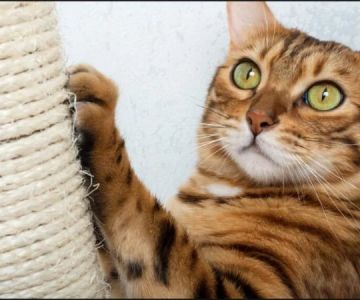
- 1. Understanding Why Kittens Scratch
- 2. Common Scratching Problems and Their Causes
- 3. Tips for Preventing Scratching
- 4. How to Train Your Kitten to Stop Scratching
- 5. Choosing the Right Scratching Post
- 6. Products to Help with Scratching
1. Understanding Why Kittens Scratch
Scratching is a natural behavior for kittens, serving several important functions. It helps them keep their claws healthy, marks their territory, and provides an outlet for excess energy. Understanding the reasons behind scratching is key to finding effective solutions for managing it.

Lawndale Pet Hospital: Paul Lynch DVM
LawndaleLos Angeles CountyCalifornia
14700 Hawthorne Blvd, Lawndale, CA 90260, USA
1.1 Claw Health and Maintenance
Kittens scratch to shed the outer layers of their claws, ensuring that they stay sharp and healthy. This is a vital part of their grooming routine.
1.2 Territory Marking
Scratching also helps kittens mark their territory. They have scent glands in their paws that release a unique scent when they scratch, signaling to other cats that the space belongs to them.
1.3 Stress Relief and Exercise
Scratching can also be a way for kittens to release stress or pent-up energy. Providing enough outlets for physical and mental stimulation is important in reducing unwanted scratching behaviors.
2. Common Scratching Problems and Their Causes
While scratching is normal, it can become a problem if it’s directed toward inappropriate areas, such as walls or furniture. Here are some common scratching problems and their potential causes:
2.1 Scratching Walls and Furniture
If your kitten is scratching walls or furniture, it may be because these surfaces are easily accessible and provide good traction. Some kittens may also scratch furniture as a way to mark their territory, especially if they are feeling anxious or stressed.
2.2 Destructive Scratching
Destructive scratching can occur if the kitten isn’t given proper outlets for its natural behavior. This can lead to damage to furniture, walls, and other household items, creating frustration for both you and your kitten.
3. Tips for Preventing Scratching
There are several steps you can take to prevent your kitten from scratching the walls or other undesirable areas. Here are some effective tips:
3.1 Provide Appropriate Scratching Surfaces
Ensure your kitten has access to suitable scratching surfaces, such as scratching posts or pads. These should be placed near areas where your kitten likes to scratch, such as walls or furniture.
3.2 Use Double-Sided Tape
One simple and effective solution is to apply double-sided tape to areas where your kitten tends to scratch. Kittens dislike the sticky texture, and this can help discourage them from scratching the area.
3.3 Trim Your Kitten's Claws
Regularly trimming your kitten's claws can reduce the damage they cause when scratching. Be sure to use proper tools and techniques to safely trim the claws without causing discomfort.
4. How to Train Your Kitten to Stop Scratching
Training your kitten to stop scratching unwanted areas requires patience and consistency. Here are some strategies to help:
4.1 Positive Reinforcement
Use positive reinforcement by rewarding your kitten with treats or praise when it uses the scratching post instead of the walls. This encourages the desired behavior and helps the kitten learn where it's acceptable to scratch.
4.2 Redirect Attention
If your kitten starts scratching in an undesirable location, gently redirect them to the scratching post. Make sure to praise and reward them when they scratch the appropriate surface.
4.3 Consistency is Key
Be consistent in your training efforts. Redirect your kitten every time it starts to scratch the wrong area, and ensure the scratching post is always available and easy to use.
5. Choosing the Right Scratching Post
Not all scratching posts are created equal, so it's important to choose one that suits your kitten’s preferences and needs:
5.1 Material and Texture
Choose scratching posts made of materials that mimic natural textures, such as sisal or cardboard. Kittens are more likely to use a scratching post that feels satisfying to scratch.
5.2 Size and Stability
Ensure the scratching post is tall enough for your kitten to stretch fully, and stable enough to withstand vigorous scratching. A stable post will prevent it from tipping over and causing frustration for your kitten.
5.3 Variety
Offering different types of scratching posts, such as vertical and horizontal options, can give your kitten variety and help prevent boredom.
6. Products to Help with Scratching
In addition to scratching posts, several products can help deter kittens from scratching the walls:
6.1 Anti-Scratching Sprays
Anti-scratching sprays are available that can be applied to furniture or walls. These sprays are designed to be unpleasant to kittens, discouraging them from scratching the treated areas.
6.2 Nail Caps
Nail caps are soft, rubber-like coverings that can be applied to your kitten’s claws. These caps prevent scratching damage while allowing your kitten to maintain its natural claw functions.
For more products and professional guidance on how to handle your kitten's scratching behavior, visit Omnia Pet for recommendations and support.








 AmbuVet Pet Ambulance4.0 (108 reviews)
AmbuVet Pet Ambulance4.0 (108 reviews) Central New Hampshire Animal Care4.0 (193 reviews)
Central New Hampshire Animal Care4.0 (193 reviews) All Points Equine4.0 (21 reviews)
All Points Equine4.0 (21 reviews) The Doggie’s Deli5.0 (157 reviews)
The Doggie’s Deli5.0 (157 reviews) Irvine Pet Hospital4.0 (311 reviews)
Irvine Pet Hospital4.0 (311 reviews) Petco4.0 (670 reviews)
Petco4.0 (670 reviews) Why Is My Dog Scooting? Common Causes and Solutions
Why Is My Dog Scooting? Common Causes and Solutions The Best Diet for a Sphynx Kitten's Oily Skin
The Best Diet for a Sphynx Kitten's Oily Skin The Most Unusual Pets That Are Legal to Own in the US | Unique Pet Ideas
The Most Unusual Pets That Are Legal to Own in the US | Unique Pet Ideas How Dogs Understand Human Language: The Science of Canine Cognition
How Dogs Understand Human Language: The Science of Canine Cognition The Best Pet Camera to Talk to Your Kitten Remotely
The Best Pet Camera to Talk to Your Kitten Remotely Why Does My Kitten Have a Bump on Their Head? Causes and Solutions
Why Does My Kitten Have a Bump on Their Head? Causes and Solutions